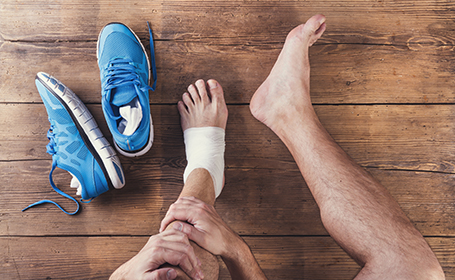
Running Injuries Q&A
We asked three of our experts about what you can do to minimise running injuries. Discover their advice on preventing injuries, how to speed up recovery, and when it's time to seek help
Our experts
We spoke to healthcare professionals from three different fields to get their different perspectives on running injuries.
- Physiotherapist Robert Waite
- Consultant Foot & Ankle Surgeon Mr Htwe Zaw, who practices at Bishops Wood Hospital and The Clementine Churchill Hospital
- General Practitioner Dr Mark Semler
Running injuries present a really fascinating challenge for the GP - there are such are broad range of underlying problems which can result from a running injury.
What types of running injuries are most common?

Robert Waite: Running injuries can come in all sorts of forms. Some of the most common I see are:
- Patellofemoral pain syndrome (PFPS)
- Achilles tendonitis
- Plantar fasciitis
- Shin splints
- Iliotibial band syndrome (ITBS)
- Hamstring tears
- Stress fractures
Mr Htwe Zaw: A variety of injuries can occur during running including the following:
- Skin damage: Blistering, callus and corns (hardened skin usually on the sole)
- Soft tissues injuries: Ankle ligament sprains, acute or chronic ankle instability (giving way), plantar fasciitis (painful heel), muscle tears, tendon injuries, nerve injuries and compartment syndrome (pain from increasing pressure within muscle compartments in the leg)
- Bones: Stress reaction (repetitive insult to bone causing pain before fracturing), stress fractures and acute fractures
- Joints: Cartilage injuries, joint dislocation
Dr Mark Semler: Running injuries present a really fascinating challenge for the GP — there are such are broad range of underlying problems which can result from a running injury.
A research article in The British Journal of Sports Medicine found that the most common injuries included (in order of frequency) patellofemoral pain syndromes, iliotibial band friction syndrome and plantar fasciitis. After this, meniscal injuries to the knee were the next most common occurrence. Other parts of the lower limb which can be affected are the Achilles tendon, the patellar tendon and calf muscle (gastrocnemius tears).
Are any of these injuries preventable?
Robert Waite: A lot of these injuries can be prevented. Firstly investing in a good pair of running shoes is important. The use of orthotics can help to reduce the stress of the lower limb. Everyone knows about warming up and down but a good regular stretching routine is vital. I'd suggest investing in a roller as this can help reduce muscle injuries after long runs.
Mr Htwe Zaw: All these conditions are preventable with appropriate footwear to suit both the running style and the terrain, pre-conditioning during training sessions, physiotherapy for balance and agility work, use of insoles and on occasions temporary use of braces, supports or taping.
Dr Mark Semler: Yes! There are some really important things to bear in mind before you start running seriously. The importance of good and appropriate footwear cannot be overestimated. Wherever possible, choose a well fitted and specialised running shoe.
If you have any pre-existing foot problem (most commonly pes planus - flat feet) you may want to consider an assessment by a sports podiatrist. This will allow what we call a 'biomechanical' assessment of the stresses and strains that are likely to affect your lower limbs while running. In some cases, a podiatrist may recommend shoe inserts — known as orthotics.
Running shoes will be very different between runners and should be individualised and renewed every 3-6 months depending on your level.

How can I prepare myself to reduce my chance of injury?
Robert Waite: A good pair of running shoes with a pair of custom made orthotics will help. Invest time in stretching and use a roller which will also help. Technique is very important, so I'd suggest joining a running club as the coaches there will help with this. It's a great social way of running too!
Mr Htwe Zaw: Understanding your running style is key. Depending on whether you are an over-pronator, heel-runner, toe-runner, barefoot runner and even backward runner, determines the likely injuries that can occur. Hence running shoes will be very different between runners and should be individualised and renewed every 3-6 months depending on your level.
The contact between feet and terrain can be enhanced with the use of appropriate insoles if necessary. Stretching routines should include sufficient time to warm up and cool down, whilst targeted physiotherapy will help strengthen muscles and tendons, improve joint awareness (proprioception), and condition joints and bones to repetitive stress.
Dr Mark Semler: Build up slowly. Evidence shows that sudden changes in activity levels are most likely to result in an injury. Your body needs to adapt to running if it's a sport that you haven't done for some time. If you can, engage a qualified Personal Trainer. They can guide you through a graded increase in your activity levels and also give you personalised tips to help you avoid an easily preventable injury.

If I get an injury while running, what action should I take?
Robert Waite: The first thing to remember is to rest, ice and elevate the injury (sometimes known as the RICE method). Then I would seek a professional opinion in the form of a physiotherapist.
Early diagnosis and treatment can really speed up the healing process
Mr Htwe Zaw: Stop running if the pain becomes persistent, as it could be a warning sign before a stress fracture or muscle injury. Apply the principles of RICE:
- Rest for initial 24hrs and weight-bear as pain allows
- Ice for up to 24hrs to relieve pain but not too long to inhibit healing
- apply Compression bandaging
- Elevate the foot
Devices that combine Intermittent compression with coolants may be considered. Take adequate pain relief, avoid bracing if possible and start simple ankle exercises at home. If symptoms persist beyond two weeks or you are unable to weight-bear, contact a healthcare professional (physiotherapist, GP, A&E, orthopaedic specialist).
Dr Mark Semler: Generally speaking, most running injuries should be treated in the same way in the immediate aftermath. This involves initial rest, mild elevation, ice packs and taking non-steroidal anti-inflammatory drugs (NSAIDs) such as ibuprofen (please check with your doctor first).
If you unable to put any weight at all on the affected leg this can act as a useful discriminator for how severe the underlying injury might be. The same is true if the affected area shows significant signs of swelling. In both of these instances, it is really sensible to get assessed in an emergency department or urgent care centre. X-rays and immobilisation of the injured area may be necessary.
There are many forms of treatment available, in the way of local massage, ultrasound and exercise prescription to help the healing process.
What treatments are available for me?
Robert Waite: There are many forms of treatment available, in the way of local massage, ultrasound and exercise prescription to help the healing process. Some physiotherapists use acupuncture and some will use a special tape. Gait analysis could also be an option, which could lead to an orthotic prescription.
Mr Htwe Zaw: Treatment will vary depending on the diagnosis so seek advice if symptoms persist or weight-bearing is too painful.
Physiotherapy will focus on functional rehabilitation, i.e. maintaining motion, early proprioception (joint awareness/balance), muscle strengthening and stretching of hamstrings, calf and Achilles tendon. Bracing the ankle temporarily can help when instability develops from ligament injuries. Insoles (orthotics) can help correct poor alignment and redistribute mechanical stresses more evenly across the foot.
Shockwave therapy (high-energy acoustic waves) has recently gained popularity in treating soft tissue conditions such as Achilles tendonitis and plantar fasciitis, and is easy to apply in the clinic.
Surgery (keyhole or open) is considered when non-surgical treatment no longer works, and aims of restore function and stability to pre-injury level.
Dr Mark Semler: This really does depend on the injury. However, there are certain broad principles which will be applicable to the treatment of all running injuries. Many injuries will settle with what are called "conservative" measures. This usually is a combination of rest, NSAIDs, physiotherapy and giving the injury enough time to heal.
If these measures fail, or if the initial injury is more severe, other types of interventions include targeted steroid injections, arthroscopy of a joint (for example a knee arthroscopy - during which a damaged meniscus can be treated) and, in the worst cases, open surgical procedures.
What can I do to aid my own recovery?
Robert Waite: Follow the advice from your physiotherapist! Don't rush back to running too soon and when you do, start slowly and build up. If you have a good base training under your belt, you will not lose fitness in a short time scale. Don't forget to use regular ice packs. Stretch the muscles regularly but never overdo it. Eating a clean diet and drinking plenty of water will also help injury prevention and, if you have an injury, the healing process.
Mr Htwe Zaw: Apply the principles of RICE. Rest the affected foot, apply Ice in the first few hours if possible. Compression bandaging helps reduce swelling unless a cast has been applied, and elevate the foot as much as possible in the first two weeks.
Take adequate pain relief with non-steroidal anti-inflammatories, and consider protected weight-bearing with crutches if instructed. if you have surgery, early post-operative rehabilitation will start once the wounds have healed at approximately two weeks.
Dr Mark Semler: Get the right advice and support. Work closely with a sports physiotherapist and let them guide and empower you to return to fitness. Don't forget - listen closely to your body. A good understanding of what your own body can and can't cope with is key to getting better quickly and also avoiding future injury.
Tags
How do I book an appointment?
If you're concerned about symptoms you're experiencing or require further information on this subject, talk to a GP or see an expert consultant at your local Circle Hospital.